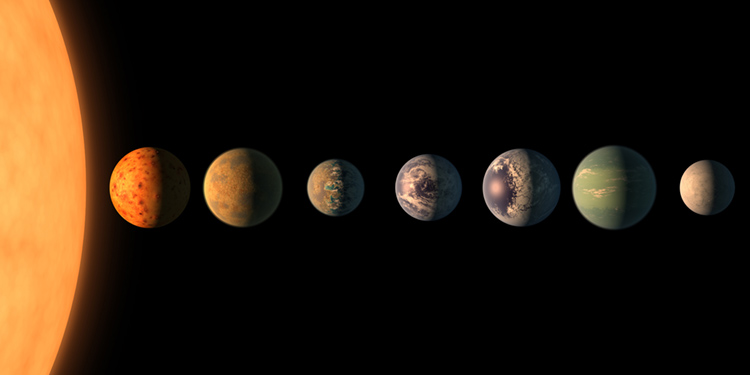Current Events Lesson Plan: February 23-March 1, 2017
Current Event: Pocket Solar System May Be Right for Life
Astronomers recently announced the discovery of a remarkable planetary system orbiting a relatively nearby star. The new system has a whopping seven planets, many of which might host conditions favorable for life. The system is located some 40 light-years away in the constellation Aquarius. One light-year is the distance that light travels in a vacuum in a year, about 5.88 trillion miles (9.46 trillion kilometers). The planets orbit a star called TRAPPIST-1, named in honor of the telescope used in the discovery. TRAPPIST stands for Transiting Planets and Planetesimals Small Telescope. The star the seven planets were orbiting was a small, relatively cool star called a red dwarf. Even the farthest exoplanet of the system orbits closer to TRAPPIST-1 than Mercury does to the sun, at a distance of only about 5.6 million miles (9.0 million kilometers). For comparison, Earth orbits about 93 million miles (150 million kilometers) from the sun. Because red dwarfs are much smaller and cooler than the sun, however, three of the planets orbit within a region that should be neither too hot nor too cold for liquid water to exist on their surfaces. Most scientists consider liquid water essential for life, so such a region around a star is known as its habitable zone.

This artist’s concept shows what each of the TRAPPIST-1 planets may look like, based on available data about their sizes, masses and orbital distances.
Credit: NASA/JPL-Caltech
Objective:
A planet is a large, round heavenly body that orbits a star and shines with light reflected from the star. Our solar system has eight known planets and five dwarf planets, including Pluto, which used to be classified as a planet. Since the 1990′s, astronomers have discovered many planetary systems around distant stars. The distant planets, called extrasolar planets or exoplanets, cannot be seen directly. But they can be studied indirectly, through small changes they cause in light coming from the parent star. The Behind the Headlines news story and related World Book articles explore planets and other astronomical topics.
Words to know:
- Aquarius
- Astronomy
- Dwarf planet
- Mercury
- National Aeronautics and Space Administration (NASA)
- Planet
- Red dwarf
- Telescope
Discussion Topics:
1. Ask your students to name other constellations besides Aquarius. (There are 88 commonly recognized constellations, including Andromeda, Aries, Cancer, Canis Major, Canis Minor, Gemini, Leo, Libra, Orion, Pisces, Sagittarius, Southern Cross, Ursa Major, Ursa Minor. Note, the Big Dipper and Little Dipper are not constellations, but smaller parts of constellations.)
2. Ask your students if they can name the eight planets and five dwarf planets that are in the solar system. (The eight planets are Mercury, Venus, Earth, Mars, Jupiter, Saturn, Uranus, and Neptune. The five dwarf planets are Ceres, Eris, Haumea, Makemake, and Pluto.)
3. Ask your students to debate “One day we will find intelligent life on another planet.”
4. Ask your students to use World Book’s Timelines feature to view or add to the Advances in Astronomy timeline. (Students may wish to use World Book’s “Astronomy” article for help.)


